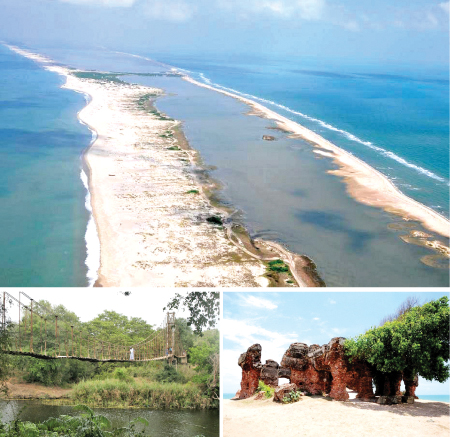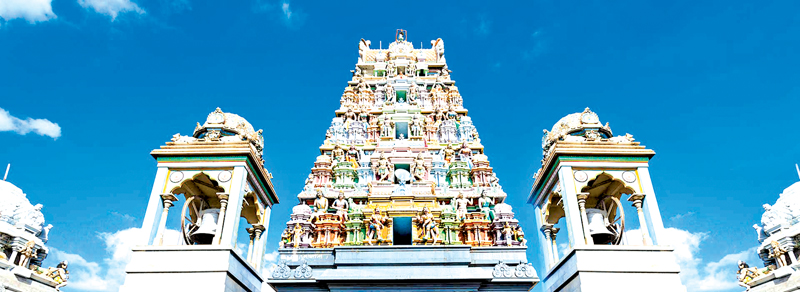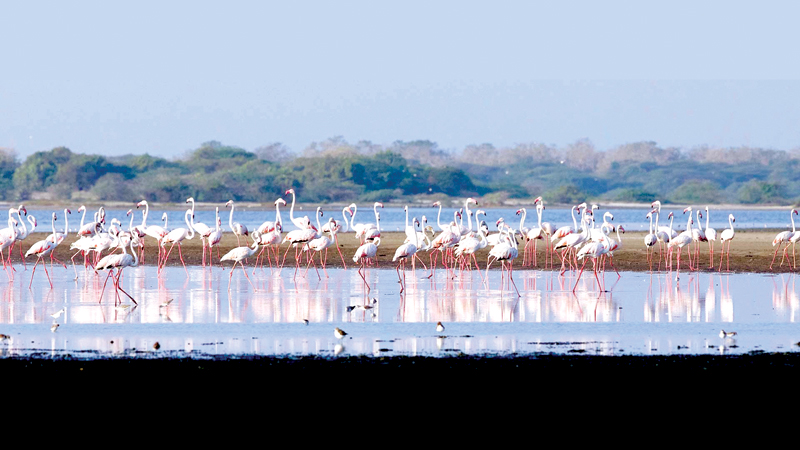 Let’s discover our own country and its breathtaking sites in these columns dedicated to Discovering Sri Lanka. Before you embark on your next trip overseas on vacation we urge you to rethink if you have travelled our own country sufficiently. Discover Sri Lanka will spotlight on our own wonderful sites that locals and foreigners alike must visit – destinations that cannot be missed in your lifetime.
Let’s discover our own country and its breathtaking sites in these columns dedicated to Discovering Sri Lanka. Before you embark on your next trip overseas on vacation we urge you to rethink if you have travelled our own country sufficiently. Discover Sri Lanka will spotlight on our own wonderful sites that locals and foreigners alike must visit – destinations that cannot be missed in your lifetime.
****
Tired of the same old tourist trails? Yearning for a destination that whispers tales of untouched beauty and serene landscapes? Forget the crowded beaches and bustling cities for a moment, and let’s journey to a place where tranquility reigns supreme: Mannar Island in Sri Lanka. While Sri Lanka’s popularity as a tourist destination continues to soar, with overall tourist arrivals showing a robust increase in 2025 according to recent industry reports, there’s a growing wave of travellers seeking experiences beyond the typical hotspots. Data at Rofi Car Rentals, gathered from collaborated travel businesses across Sri Lanka, indicates a remarkable 63.82% surge in inquiries for off-the-beaten-path destinations like Mannar Island in the past year alone. If you’re seeking an off-the-beaten-path adventure in Sri Lanka, look no further. Let’s delve into the captivating insights of Mannar Island, your next unforgettable destination.
 Mannar Island, formerly spelt Manar Island, which lies off the north-western coast of Sri Lanka, is part of the Mannar District, Sri Lanka. It is linked to the main island of Sri Lanka by a causeway and the Mannar Bridge, which carries the A14 highway and a railway bridge. It has an area of about 130 square kilometres (50 sq mi), mainly covered with vegetation and sand.
Mannar Island, formerly spelt Manar Island, which lies off the north-western coast of Sri Lanka, is part of the Mannar District, Sri Lanka. It is linked to the main island of Sri Lanka by a causeway and the Mannar Bridge, which carries the A14 highway and a railway bridge. It has an area of about 130 square kilometres (50 sq mi), mainly covered with vegetation and sand.
Mannar Island is rich in history and natural beauty. Explore the ancient Baobab trees, Adam’s Bridge and the unique landscapes that blend sandy beaches with lush greenery, historical intrigue and untouched natural wonders.. The island is also a bird-watchers’ paradise. Mannar is an island that is considered to be the closest to India and was once a major terminal for travellers journeying between both countries.
Etymology
In the Tamil language Mannar means the raised place [of sand] which is thought to have come from the geology of the island which was formed by the accumulation of sand.
History
Scholars identify the old Sinhalese name “Mahapatan-ju which is mentioned in Sigiri graffiti as the island of Mannar.” During the separatist war (1983–2009), Muslim inhabitants of the island were forced to leave by the Tamil Tigers but some have returned since.
Energy
The largest wind harness in Sri Lanka currently comes from Mannar island, from the 100 MW Wind Power Plant of the Ceylon Electricity Board. This plant connects to the national grid by a 220 kV Inter-connector Grid Substation at Nadukuda. GSS has the provision to connect another 200 MW and the island has more capacity if required in the future. Substation construction and installation is done by Minel Lanka under the main contract by Siemens, India.
Geography
The island lies at the eastern end of the Adam’s Bridge, a chain of limestone shoals between Pamban Island (also known as Rameswaram Island), off the south-eastern coast of Tamil Nadu, India, and Mannar Island. Geological evidence suggests that this may have been a land connection between India and Sri Lanka. Fishing is an important part of the economy.
Settlements and transport
 The main settlements on the island are Mannar and Erukkulampiddi on its eastern coast, and Pesalai on its northern coast, all connected by the A14 road which leads across the bridge to the mainland Sri Lanka.
The main settlements on the island are Mannar and Erukkulampiddi on its eastern coast, and Pesalai on its northern coast, all connected by the A14 road which leads across the bridge to the mainland Sri Lanka.
Talaimannar, on the north-western coast of the island, is the terminus for the Mannar railway line.
Between 1914 and 1964, there was a train and ferry link from mainland India via Dhanushkodi and Talaimannar to Colombo, but this was not resumed after the disastrous damage caused by a cyclone in 1964. The Palk Strait Bridge was proposed in June 2015, to link mainland India to Mannar.
Environment
The island is home to baobab trees, brought from Africa by Arab merchants centuries ago. The island is within the Central Asian Flyway, a heavily used route for migratory birds that crosses 30 countries from Siberia to the Indian Ocean, and the Vankalai Bird Sanctuary is just south of the island on the mainland.
Sand mining
The mineral ilmenite, from which titanium dioxide is made, is plentiful in the islands sand. Titanium dioxide is a white pigment with a variety of uses, including in paint, plastics and cosmetics. The Perth-based Australian company, Titanium Sands has been doing exploratory drilling and has estimated reserves of up to 265 million tonnes of ilmenite and have started the process of applying for a permit to mine the sand.
However, environmental scientists are concerned about the impact of future drilling on birds and other wildlife. The company has said that an environmental impact assessment, followed by public consultation, would be undertaken before a mining license can be granted.
Planning your Mannar adventure: A travel guide
Getting to Mannar: The most convenient way to reach Mannar is by road. While public transport is available, for maximum flexibility and comfort, especially when exploring different parts of the island, renting a car is highly recommended. The A14 highway connects Mannar to the mainland, making it easily accessible.
Best time to visit: The dry season, from March to September, is generally considered the best time to visit Mannar, offering sunny skies and calm seas. However, for bird watching, the migratory season (October to April) is ideal.
Accommodation: Mannar offers a range of accommodation options, from guesthouses to small hotels. Consider staying in Mannar town or near Talaimannar for easy access to attractions.
Exploring Mannar: To truly experience the freedom to explore Mannar Island at your own pace, consider renting a car. Self-driving allows you to discover hidden beaches, reach remote bird watching spots and explore the island’s historical sites with ease and convenience. Before you hit the road, make sure you are familiar with driving in Sri Lanka and the recognition permit requirements if you are a foreign driver.
Things to do in Mannar:
Visit places of worship
• Visit Thiruketheeswaram Kovil – a Hindu temple dedicated to Lord Shiva that dates back to 600BC.
The island of Mannar is home to several places of worship that allows you to understand the diverse cultures that live in the area. Two major places that should be included in your itinerary are the Thiruketheeswaram Kovil and the Church of Our Lady of Madhu. The Thiruketheeswaram Kovil is considered to be one of the five Pancha Iswaram (five designated temples for the worship of Lord Murugan), thus making it one of the most sacred Hindu temples in the entire island.
On the other hand, the Church of Our Lady of Madhu is an example of how there is a strong Catholic community as well. Many interesting festivals are organised by these places of worship, in which you can participate as well.

EXPLORING MANNAR
A Stroll through heritage
Wander through Mannar Fort – initially built by the Portuguese in 1560 which subsequently fell to the Dutch and finally to the British. During the days of Dutch colonialism in the 17th century, Mannar was an island that was heavily fortified since it was used as a stronghold to maintain the trade monopoly, and the offshore pearl banks. All this can be seen when you explore the Mannar Fort, as the complex still has quite a few remnants, such as the chapel, dungeon, and the bell tower. The Mannar Fort is also known for its splendid views of the Indian Ocean and the surrounding town. There are several other colonial monuments that are scattered across the island that narrates quite a story to anyone who is interested, thus making it a good opportunity for you to discover an interesting past.
Revel in the Views of a mythical bridge
The northernmost point of the Mannar lies the lighthouse that allows you to witness a series of islands that is believed to be the remains of a bridge that is steeped in mythology. Believed to have been an ancient bridge that connected the island to India, these islands are heavily featured in the Ramayana chronicles as the very bridge used by Lord Hanuman to crossover to the island of Lanka and help out his friend Prince Rama during his conflict with the demon King Ravana. Although such a bridge no longer exists, it is here that you can witness some of the finest sceneries in the entire western coast, since it gives unhindered views of the horizon. Strolling along the golden sands near the lighthouse with an amazing view in the distance as the sun sets is the perfect way to unwind and relax in Mannar.
Relax on a quiet beach
Relax by Keeri Beach with a refreshing thambili.
Keeri Beach is the perfect place for those looking for a quiet stretch of golden sands to themselves. Hidden away from the crowds, the quiet beach is a great place to witness the sunset from too. Mannar Island boasts some of the most pristine beaches in Sri Lanka. Unlike the bustling shores of the south, Mannar’s beaches offer tranquility and seclusion. Imagine stretches of golden sand meeting the turquoise waters of the Indian Ocean, often with barely another soul in sight.
Talaimannar Beach, located at the westernmost tip of the island, is a must-visit. It’s the closest point to India from Sri Lanka, and on a clear day, you might even catch a glimpse of the Indian coastline. The beach here is perfect for leisurely walks, sunbathing, and simply soaking in the serenity. Another notable beach is near Vankalai, known for its migratory birdlife, offering a unique combination of beach relaxation and nature observation. For those seeking untouched beauty and peaceful escapes, Mannar’s beaches are an absolute paradise.
The great Baobab tree:
A historical giant
One of Mannar’s most iconic landmarks is the Great Baobab Tree, a majestic sentinel standing tall against the island’s skyline. This ancient tree, estimated to be over 800 years old, is not native to Sri Lanka, sparking fascinating theories about its arrival. Some believe it was brought by Arab traders centuries ago, while others suggest it washed ashore. Regardless of its origin, the Mannar Baobab tree is a testament to time and nature’s resilience.
Visiting this historical giant is a truly awe-inspiring experience. Its massive trunk and sprawling branches create a sense of wonder, and its presence speaks volumes about the island’s rich past. Don’t miss the opportunity to stand in the shade of this ancient marvel and ponder the stories it could tell. To learn more about Baobab trees, you can visit Britannica’s page on Baobab.
Adam’s Bridge:
Myth, History, and Natural Wonder
Perhaps the most intriguing feature associated with Mannar is Adam’s Bridge, also known as Rama Setu. This chain of limestone shoals stretching between Mannar Island and Rameswaram in India has captured the imagination for centuries. Rooted in Hindu mythology, it’s believed to be the bridge built by Lord Rama’s army to reach Lanka in the epic Ramayana.
While the mythological significance is profound, Adam’s Bridge is also a remarkable natural formation. Though much of it is submerged, parts are visible, and the shallow waters are teeming with marine life. While physically traversing the entire bridge is not possible, you can visit areas on Mannar Island that offer views towards Adam’s Bridge Sri Lanka.
Bird Watching Paradise:
A Haven for Avian Enthusiasts
For nature lovers, bird watching in Mannar is an absolute delight. The island’s diverse ecosystems, including lagoons, salt marshes, and scrublands, attract a wide variety of bird species, particularly migratory birds. Vankalai Bird Sanctuary, located on the south coast of Mannar Island, is a Ramsar Wetland site and a prime spot for birdwatching.
During the migratory season (roughly October to April), you can witness thousands of flamingos, pelicans, painted storks, and various waders flocking to the lagoons. Even outside the peak season, Mannar offers excellent birding opportunities with resident species like Sri Lanka wood pigeons, barbets, and various raptors. Bring your binoculars and prepare to be amazed by the avian spectacle. You can find bird identification guides and more information at BirdLife International, a global partnership for bird conservation.
Beyond the highlights
Beyond the beaches, Baobab tree, the Adam’s Bridge, and bird watching, Mannar offers a range of experiences for the adventurous traveler. Explore the historic Mannar Fort, a Portuguese-built fort later occupied by the Dutch and British, reflecting the island’s colonial past. Visit the Doric Bungalow at Arippu, a unique architectural relic showcasing colonial-era design.
Immerse yourself in the local culture by visiting the bustling Mannar town market, where you can sample local produce and interact with friendly islanders. Consider a boat trip to explore the smaller islands around Mannar or to try your hand at fishing. Mannar offers a slower pace of life and authentic Sri Lankan experiences away from the tourist crowds.
Conclusion:
Discover the untouched Mannar island
Mannar Island is a destination that rewards the adventurous traveller. Its untouched beauty, historical significance, and natural wonders offer a unique Sri Lankan experience. From pristine beaches to ancient trees and legendary bridges, Mannar is a place of discovery and tranquility. – Courtesy – Sri Lanka Tourism Alliance
– Courtesy – By Edward Yang of Rofi Trip Guide




